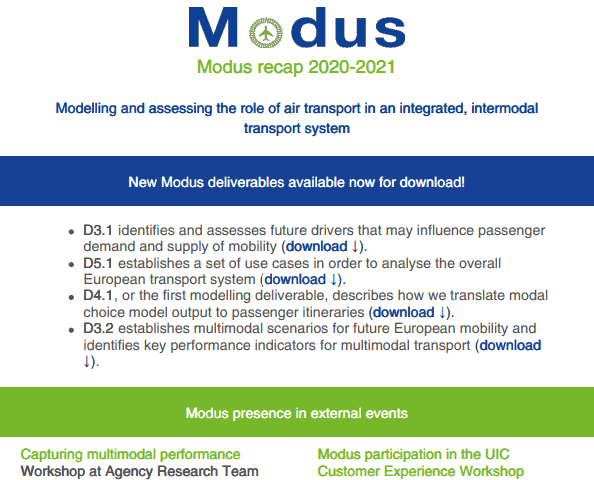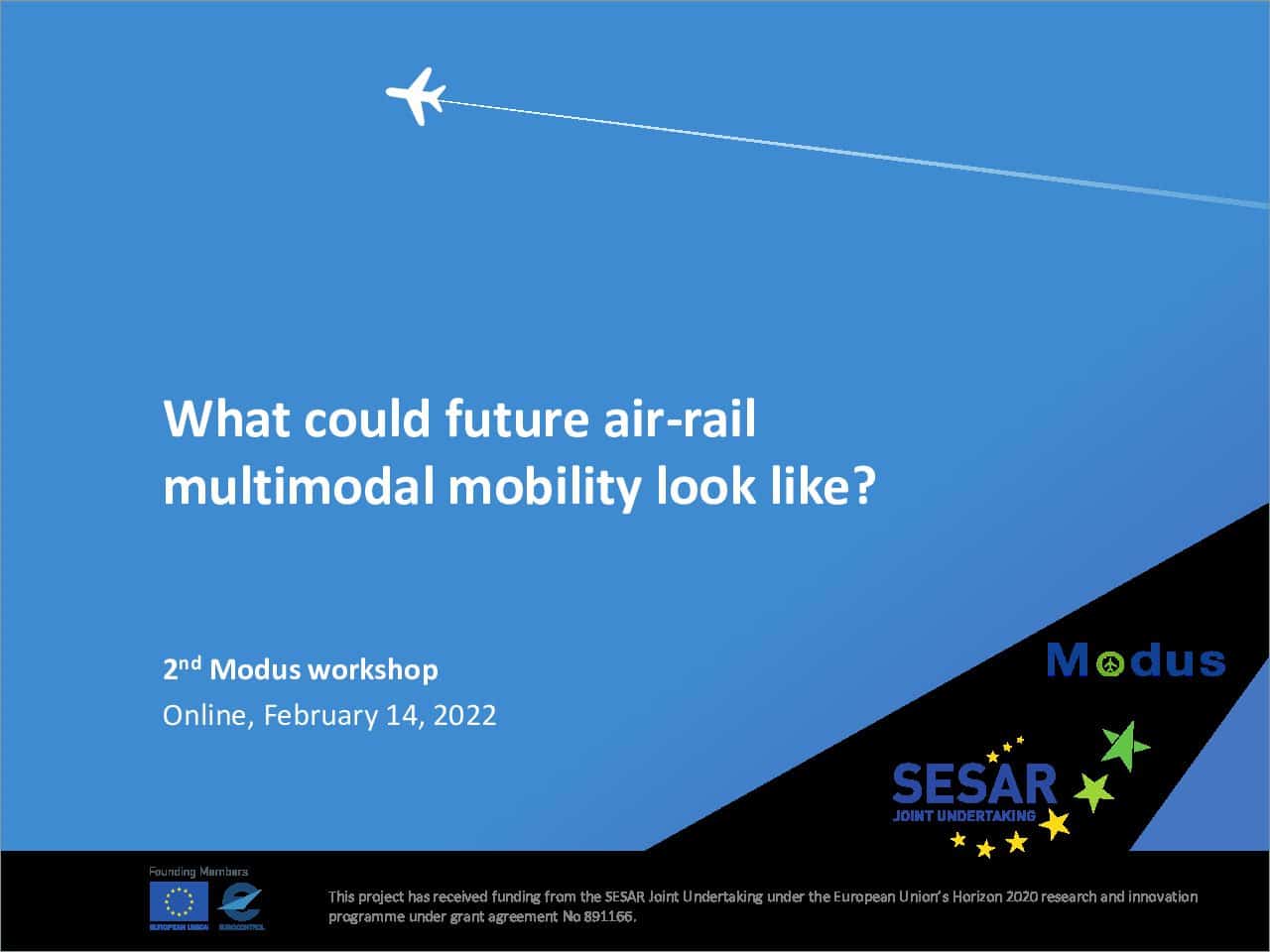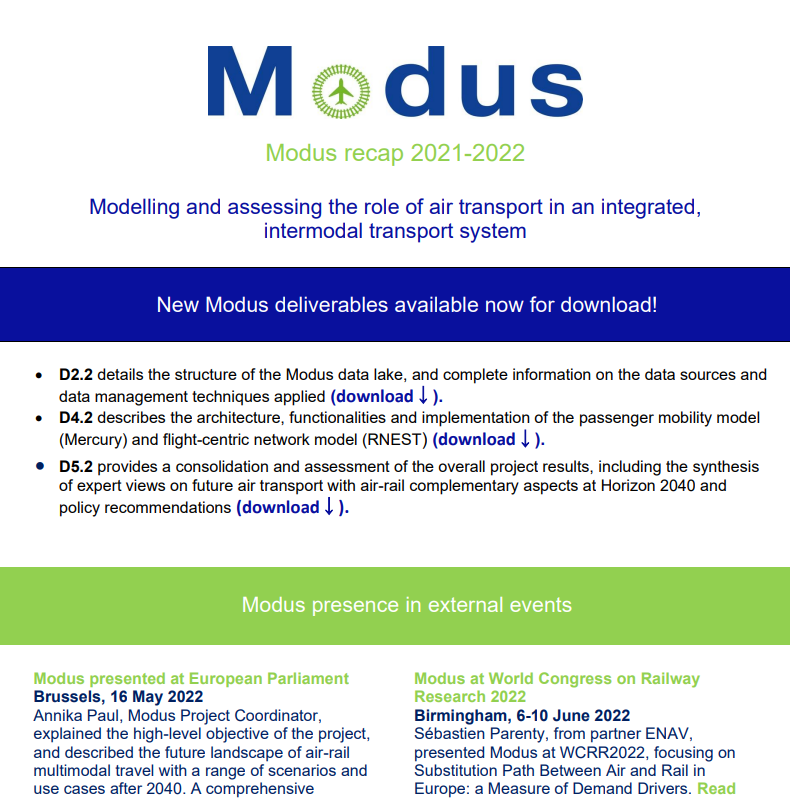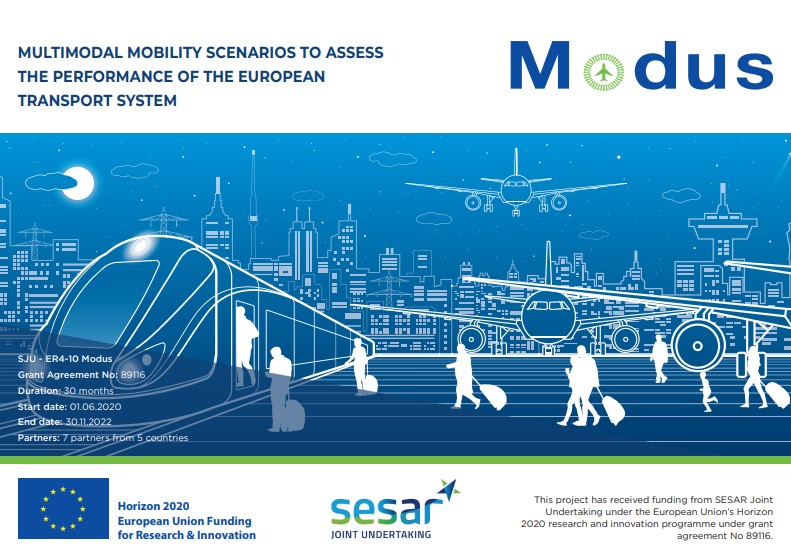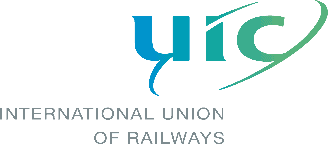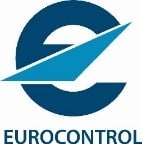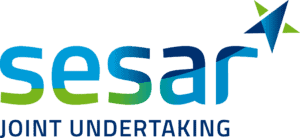Modelling and assessing the role of air transport in an integrated, intermodal transport system
Overview
In the context of increasing environmental awareness, regulatory measures, capacity shortages across different modes, or the need for a more seamless and hassle-free passenger journey, the future evolution of European travellers’ demand for mobility is still unknown, as well as its potential impacts on the European transport system. The optimization and alignment of intermodal transport is therefore of utmost importance for the overall performance of the (future) European transport system, especially in regard to providing a seamless and hassle-free journey for passengers as well as mitigating (air) capacity constraints
Ready to win with real money slots? Get started by choosing an online casino.
The main objective of the project is the analysis of the performance of the overall transport system by considering the entire door-to-door journey holistically and assessing the role of air transport within an integrated, intermodal approach. For this purpose, Modus identifies and assesses (future) drivers for passenger demand and supply of mobility in terms of their impact on passenger mode choice. This enables the development of multiple scenarios of future mobility paths, taking into account aspects such as new regulatory contexts meeting new environmental standards, or new transport operators’ business models, covering a time horizon of 2040+.
Facts and figures
Acronym: Modus
Project budget : 1 m€
Duration: 30 months
Project start date: 01/06/2020
Project end date: 30/11/2022
Partners: 7 partners from 5 countries
Project coordinator: Bauhaus Luftfahrt
Work programme: H2020-SESAR-2019-2
Grant agreement n° 891166
Project objectives
Understand
in a better way how ATM and air transport can better contribute to improve passengers’ intermodal journeys and how this translates into an enhanced performance of the overall transport system
Explore and model
the connection and dependence between ATM/ air transport and other transport modes, with a special focus on the interplay between short and medium air and rail connections
Identify
the main barriers in achieving European (air) mobility goals and how air transport can evolve by efficiently connecting information and services with other transport modes to achieve the 4 hours door-to-door goal and a seamless journey experience for passengers.
Project structure
| WP Number | WP Title | Lead beneficiary |
|---|---|---|
| WP1 | Coordination and Management | BHL |
| WP2 | Data Acquisition and Management | INX |
| WP3 | Future Supply and Demand Scenarios | ENAC |
| WP4 | Passenger Mobility Modelling | UoW |
| WP5 | Identification of Gaps and Barriers | BHL |
| WP6 | Dissemination and Exploitation | UIC |
| WP7 | Ethics requirements | BHL |
Implementation approach
WP3 will focus on the future supply and demand scenarios. It will identify the drivers for future demand and supply and develop a modal choice model which will be used by the development of scenarios activities. WP3 will then identify which indicators need to be monitored and developed to capture the particularities of the connectivity of passengers in a multimodal environment. The generated demand and supply flows in WP3 will feed the mobility models implemented in WP4. First an interface between these flows and individual passenger itineraries will be created. This will also transform the information from the scenarios into specific input for the models. Two mobility models will complement each other on the analysis: a passenger mobility model and a flight-centric network model. These models will be based on state-of-the-art tools previously developed by members of the consortium and will provide detailed flight and passenger metrics in the full door-to-door context. The runs of these tactical models carried out in WP4 will feed the quantitative and qualitative analysis carried out in WP5 which will be devoted to the identification of gaps and barriers and of the definition of use cases. Finally, all these activities will be supported by close interaction with the Industry Board and validation activities managed from WP1.

Publications
Sesar Innovation Days – teaser
Modus presentation Sesar Innovation Days
2nd Workshop Modus, “What could future air-rail multimodal mobility look like?”
Modus Final dissemination workshop /3
Modus Final dissemination workshop /4
Scientific publications

Papers
A. Montlaur, L. Delgado, C. Trapote-Barreiram (2021) Analytical Models for CO2 Emissions and Travel Time for Short-to-Medium-Haul Flights Considering Available Seats. Sustainability MDPI in: Sustainability, Journal 2021. https://www.mdpi.com/2071-1050/13/18/10401
Events/Congress/Workshops
- A. Paul (2020), Greener airports operations Flying, the multimodal way! in: SESAR JU E-Workshop, online, November 2020.
- A. Paul (2020), Modus: Modelling and Assessing the Role of Air Transport in an Integrated, Intermodal System, in: SESAR Innovation Day 2020, online, December 2020.
- A. Paul (2021), Modus project update and expert survey in: ACARE WG1, January 2021.
- A. Paul (2021), How the ATM Scientific Community can support the Multimodal Transportation System Effectiveness. in: Agency Research Team (ART) workshop on passenger-centred mobility, online, June 2021.
- A. Cook (2021), Key Performance Indicators in: Agency Research Team (ART) workshop on passenger-centred mobility, online, June 2021.
- A. Paul (2021), Passenger travel behaviour in a future multimodal system – Insights from the Modus project, in: UIC Customer Experience Management Platform (CEMP) Workshop, online, June 2021.
- P. Arich, T. Bolic, I. Laplace, N. Lenoir, S. Parenty, A. Paul, C. Roucolle (2022), Substitution path between air and rail in Europe: a measure of demand drivers, in: WCRR 2022, Birmingham, June 2022.
- A. Paul (2021), Modus: Modelling and Assessing the Role of Air Transport in an Integrated, Intermodal System, in: SESAR Innovation Day 2021, online, December 2021.
- A. Paul (2022), What could future air-rail multimodal mobility look like? Insights from the Modus project; in: Presentation for the EU Parliament Committee on the Modus project regarding ‘Aviation, maritime and rail transport in a multimodal EU transport system: comparative advantages between modes and efficiency gains of integration – PART 2: best practices in multimodal integration analysis and design’, online, May 2022. 2022. https://multimedia.europarl.europa.eu/fr/webstreaming/tran-poldep-b-workshop_20220516-1645-COMMITTEE-TRAN
- N. Pilon (2022), Modus Scenarios for Future of Multimodal Travel: Horizon 2040, in: Passenger Terminal Expo, Paris, June 2022.
- P. Arich, T. Bolic, I. Laplace, N. Lenoir, S. Parenty, A. Paul, C. Roucolle (2022), Substitution path between air and rail in Europe: a measure of demand drivers, in: WCRR 2022, Birmingham, June 2022.
- U. Schmalz (2022), Future Technologies and Trends – Assessing Drivers of Change, in: ILA Berlin, June 2022,
- A. Paul, U. Schmalz, I. Laplace, A. Cook, T. Bolic, V. Perez, N. Pilon (2022), Developing Multimodal, Air-Rail Scenarios for Europe (Modus project), in: ATRS, Air Transport Research Society World Conference, Antwerp + online, Aug. 2022.
- P. Arich, T. Bolic, I. Laplace, N. Lenoir, S. Parenty, A. Paul, C. Roucolle (2022), Substitution path between air and rail in Europe: a measure of demand drivers, in: ATRS, Antwerp, online, August 2022.
- I. Correas, A. Correas, E. Gregori (2022), Quantification Model for Local Itineraries in Urban and Peri-Urban Areas Using Open Data, in: ETC 2022, Milan, Sept. 2022.
- A. Paul (2022), Connected mobility systems, in: Symposium Sustainable Aviation, Hamburg November 2022.
- P. Arich, I. Laplace, S. Parenty, C. Roucolle, A. Paul, T. Bolic (2022), Air and rail competition in Europe: measures of substitution paths, in: INAIR 2022, Bratislava, November 2022.
- A. Perez (2022), Modus Scenarios for the Future of Multimodal Transport: Horizon 2040, in: World Passenger Festival, Amsterdam, November 2022.
- A. Paul, U. Schmalz, I. Laplace, A. Cook, T. Bolic, V. Perez, N. Pilon (2022), Future multimodal mobility scenarios within Europe, in: Transport Research Arena Conference, Lisbon, November 2022.
- L. Delgado, A. Cook, E. Zareian, T. Bolic, E. Gregori, A. Paul, Challenges of multimodal door-to-door mobility modelling; in: SESAR Innovation Days 2022, Budapest, Hungary, December 2022.
Project deliverables
| Deliverable number | Deliverable name | Work Package | Lead partner | Delivery date |
|---|---|---|---|---|
| 3.1 | Modal choice analysis and expert assessment | 3 | ENAC | M8 |
| 4.1 | Interface to modal choice model: methodology | 4 | INX | M12 |
| 3.2 | Demand and supply scenarios and performance indicators | 3 | BHL | M13 |
| 5.1 | Definition of use cases | 5 | BHL | M13 |
| 4.2 | Mobility models description | 4 | UoW | M20 |
| 2.2 | Database Structure | 2 | INX | M21 |
| 5.2 | Final project results report | 5 | BHL | M22 |
| 6.2 | Final Dissemination Report | 6 | BHL | M30 |
News & Events
Registration 2nd Online Workshop Modus
Modus: Modelling and assessing the role of air transport in an integrated, intermodal transport system 2nd Online workshop, Save the date 14 February 2022 "What could future air-rail multimodal mobility look like?" The SESAR project ‘Modus’ is exploring the future...
Second online Modus workshop, save the date 14 February 2022!
The second Modus workshop, ‘‘What could future air-rail multimodal mobility look like?’’, will be held online on 14 February 2022. The SESAR European ‘Modus’ project is exploring the future landscape of air-rail multimodal travel with a range of future scenarios....
Are you curious about the progress made since our first Modus Workshop in January 2021?
Please find everything in the Modus Newsletter: MODUS 2021 NEWSLETTER
Discover our Deliverable 3.2 ‘Demand and supply scenarios and performance indicators’
Taking a traveller-centric perspective, this deliverable presents four scenarios and seven future European traveller archetypes by 2040. Download it from https://bit.ly/3oXLMlT. Each scenario focuses on specific aspects envisaged for the future which have the...
European Modus project at SESAR Innovation Days 2021
The Modus project was represented for the second time at the SESAR Innovation Days (SIDs) held online from 7 to 9 December. The second day of the event featured a plenary session on ‘Multimodality, why is it taking so long?’ moderated by Andrew Cook (University of...
Deliverable ’Definition of use cases’ is published
The deliverable from Modus Work Package 5 concerning identification of gaps and barriers can now be downloaded from https://bit.ly/3lFf7Qm One of the main goals of the Modus project is to analyse how the overall performance of the European transport system can be...
Download the first deliverable of WP4 of the Modus project
This document aims to develop highly detailed low-level results on the present and future of the mobility of passengers in Europe based on flight and passenger metrics. The purpose of this deliverable is to describe the methodology designed and developed to translate...
New deliverable now available! Modus D3.1 Modal choice analysis and expert assessment for download ⚠️
The deliverable D3.1 - Modal choice analysis and expert assessment - is now available for download on the Modus website. This deliverable is part of a project that has received funding from the SESAR Joint Undertaking under grant agreement No 891166 under European...
Customer Experience Management Platform (CEMP) workshop held online on 21 June
More than 100 participants registered for a workshop on the Customer Experience Management Platform (CEMP) held on 21 June. Current strategies and solutions that operators and industry are working on to improve the customer experience and to prepare for potential...
Modus at Agency Research Team (ART) workshop on passenger-centred mobility
EUROCONTROL ART, the Advisory Council for Aeronautics Research in Europe (ACARE) Working Group on Mobility, Institute for sustainable society and innovation (ISSNOVA) and the Horizon 2020 Coordination and support action for mobility in Europe: research and assessment...
Newsletters/Others
- A. Paul (2020), Flying, the multimodal way! in: SESAR JU E-News, June 2020, https://cdn.flxml.eu/r-64bd51e08709b6f95e8172403393c44a, https://www.sesarju.eu/news/flying-multimodal-way
- N. Pilon (2021), Is the future of European transport multimodal?, in: EUROCONTROL/INO internal newsletter, Feb. 2021
- U. Schmalz (2022), Personalisation of aviation. Passenger profile of the future. Airlines.de Sept. 2022
News from Modus website have been systematically published at UIC Enewletter
Consortium
Bauhaus Luftfahrt
Bauhaus Luftfahrt is an interdisciplinary research institution funded by the four aerospace companies Airbus Group, Industrieanlagen-Betriebsgesellschaft (IABG), Liebherr-Aerospace and MTU Aero Engines as well as the Bavarian Ministry of Economic Affairs, Regional Development and Energy. The non-profit association is an internationally-oriented think tank. Bauhaus Luftfahrt e. V. was founded in November 2005 and is based on the Ludwig Bölkow Campus in Taufkirchen near Munich since 2015.
École nationale de l'aviation civile
L’Ecole Nationale de l’Aviation Civile (ENAC) or French Civil Aviation University is a public institution under the supervision of the French Ministry of transport. Its mission is to provide ab-initio and further training for the executives and main players of the civil aviation world and do research in a variety of air transport related domains. ENAC offers a wide range of activities that are tailored to meet the requirements of the public and private sectors both in France and in other countries. Based in Toulouse, France, ENAC is one of the top universities in the world devoted to the aviation industry (about 2000 students for Ab-Initio Training and 4500 trainees for Continuing Education and training and more than 140 researchers).
University of Westminster
The University of Westminster’s planning and transport research team has been engaged in transport research, consultancy, and teaching for over 40 years. The broad social and behavioural research of the University allows us to examine transport issues in a holistic and integrated context, with a substantial focus on door-to-door passenger mobility and choice paradigms. Such work has included choice determinants for rail, including novel modelling of how perceived reliability drives modal share. Areas of transport research include: travel planning and mobility management, transport and social exclusion, urban public transport and accessibility planning, plus a core speciality of air traffic management: with a particular emphasis on performance assessment, economics and operations. In addition, the team has 20 years’ experience in user requirements studies and technical market research, plus an established history of quantitative and qualitative analytical techniques.
Fundacion Instituto De Investigacion Innaxis
Innaxis Research Institute (INX) is a private and independent research institution founded with the goal of addressing complex scientific challenges of significant social and economic impact. Innaxis’ research agenda focuses on the study of large-scale, network-based socio-technical systems such as energy or transport by using an interdisciplinary approach and the state of the art in data science, mathematical modelling, nonlinear systems, predictive analytics and computational simulation.
Union Internationale des Chemins de fer
UIC is the worldwide organisation for international cooperation among railways and promotion of rail transport at a global level. Founded in 1922, it currently gathers 200 members on all 5 continents, among them rail operators, infrastructure managers, etc. The mission of the association is to promote rail transport at world level with the objective of optimally meeting current and future challenges of mobility and sustainable development.
Skymantics Europe, SL
Skymantics Europe is a technical consulting firm that provides services in information technology for the aviation and transportation industry. The company team has broad expertise in system conceptualisation, test and validation, and bring-to-market activities for travel planning, routing and multimodal connectivity based on open geospatial data and Internet of Things (IoT) capabilities. Skymantics Europe is positioning itself as an innovation laboratory for solutions enabling global connectivity of all stakeholders into the transport network, with the objectives to improve performance, efficiency and safety of the EU transportation infrastructure.
EUROCONTROL
EUROCONTROL, the European Organisation for the Safety of Air Navigation, is an intergovernmental Organisation with 41 Member States, committed to building, together with its partners, a Single European Sky that will deliver the ATM performance required for the 21st century. EUROCONTROL employs more than 1,900 highly qualified professionals spread over four European countries.
Links
SESAR https://www.sesarju.eu/projects/modus
Interview with Modus coordinator: https://www.sesarju.eu/news/flying-multimodal-way
Contacts
Project coordinator
Annika PAUL – BHL
annika.paul@bauhaus-luftfahrt.net
Communication and dissemination
Vanessa PÉREZ – UIC
perez@uic.org
Modus online
Website : https://modus-project.eu/
Twitter: https://twitter.com/modus_project (@Modus_project)
LinkedIn: https://www.linkedin.com/company/moduseuproject
Social Media: #modus_eu



